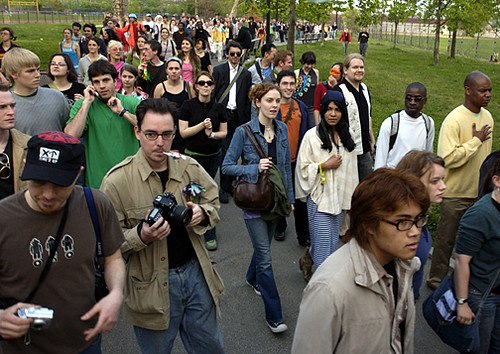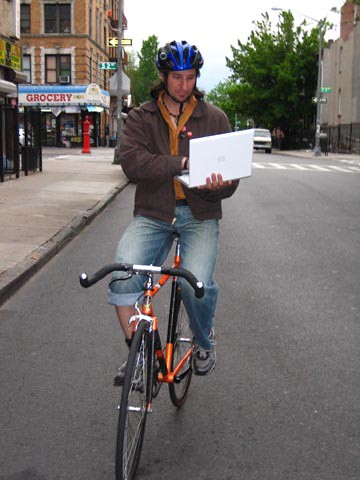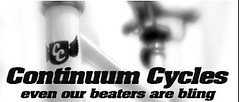Article
This is a picture of first warm night. More pictures can be found at: www.firstwarmnight.com
I couldn't make the event but it sounds like a success. At least people were able to have a taste of what a free roving street party can be about. It also sounds like 60-70 bikes riding in mass was not attacked or harassed by the police...for a change.
Here is an article from NY cycling advocate Charlie Komanoff
The Need for More Cyclists
Remarks of Charles Komanoff
Bicycle Education Leadership Conference / League of American Bicyclists
New York City • May 3, 2005
There is nothing ailing the world that can’t be helped by more bicycling. Name your favorite, or unfavorite malady, and I’ll tell you how more cycling will help.
Global warming (climate havoc)?
Peak oil / oil depletion?
U.S. collaboration with despotic regimes that spawn terror?
Traffic gridlock?
Urban decay and community disintegration?
Disease and disability?
Exploding medical costs?
Youth alienation?
(Ask for volunteer maladies)
The world needs more bicycling. Bicycling needs more bicycling, as I explain later. My point now — my hope in our time together today — is to broaden your mission; to expand it from safe cycling and effective cycling to more cycling. Because more cycling is not only good for your town and our planet; it’s the best way to get to safe cycling and effective cycling.
Let’s begin with a few key questions.
What is safe cycling?
What is safety?
Is safety not part of something larger, called health?
My pole star for these questions is the noted policy analyst Mayer Hillman. In a landmark study for the British Medical Association, Hillman found that the health benefits of regular cycling, in terms of life years gained, far outweighed the actuarial loss of life from road accidents.
Even in Britain’s anti-cycling road environment, Hillman found, each minute of lost life-expectancy from the increased probability of crash injury or death to some cyclists was offset 10-fold by the increased longevity from improved cardiovascular health of other cyclists.
Let me put this a different way: Hillman demonstrated the risk of not cycling.
This is not just a rhetorical point — though it’s very effective rhetoric, as I find in conversations with non-cyclists here. “How can you ride a bike in New York City?†they ask, and I say, “I couldn’t live here if I didn’t ride a bike.†“Isn’t it dangerous?†they say, and I say, “It’s dangerous not to,†and then I tell them about Hillman.
There’s a further point, just as important — for us — as Hillman’s. It’s the benefit to cyclist safety when more people cycle.
Cyclists like having other cyclists around. Not just to lend a wrench or help fix a flat, but for a far bigger reason: our larger presence on the road compels drivers to take notice of us.
Researchers in several countries are documenting, and quantifying, this safety-in-numbers effect: they’re observing a “power law†relationship of approximately 0.6 between cyclist numbers and cyclist safety.
What does that mean? It means that the probability that an individual cyclist on a particular road or in a city or region will be struck by a motorist declines with the 0.6 power of the number of cyclists on that road or in that region.
Maybe I should give an example. Say the number of cyclists triples. Since three raised to the negative 0.6 power is roughly one-half, each tripling in cycling volume brings about a halving of each cyclist’s crash risk.
Now say the number of cyclists increases nine-fold, that is, triples twice. Then each cyclist’s crash risk is halved twice, i.e., it falls by three-fourths.
Safety-in-numbers means that none of the things we talk about for individual safety — helmets, blinkies, Effective CyclingTR — will improve the safety of the individual cyclist as much as increasing the number of cyclists on our roads.
That’s why I say that what bicycling mostly needs is... more bicycling.
For those of you who regard rider skills as paramount, consider this striking, and disturbing, finding from our Killed By Automobile study of road fatalities in New York City.
First, remember that most driving in the five boroughs is by men — we estimated 75%, taking account of taxis, buses, trucks, and other male/female employment differences.
So, all things equal, 75% of cyclist fatalities here would have come from bike crashes with motor vehicles driven by men, and 25% from crashes with vehicles driven by women, right?
Not even close.
Over the four-year period we studied, with 71 bicyclist fatalities, and the driver identified for 63 of them, 61 of the drivers who killed bicyclists were male and 2 were female. That’s a 97%/3% gender split, rather than the expected 75/25.
Per mile driven, male drivers killed bicyclists at 10 times the rate of female drivers.
The grossly disproportionate number of male cyclist-killers strongly suggests that driver aggression (and not just cyclist impulsiveness or incompetence) plays a significant role in killing bicycle-riders in New York City — a finding confirmed in a later report showing that the foremost behavior that’s killing cyclists is aggressive passing by drivers.
Short of mandating sex-change operations for motorists, how do we make cycling safer?
I’ll mention two ways.
One is to achieve the “numbers†part of safety-in-numbers quickly, by promoting and participating in the worldwide monthly cycling event known as Critical Mass.
Raise your hand if you’ve ever ridden in Critical Mass.
What makes Critical Mass so much fun?
Flipping off car drivers? No.
Blocking traffic? Well... not really.
What makes Critical Mass feel so good, even magical, is the chance it offers to ride a bike without being swamped by a sea of cars and the chance to enjoy the astonishing fact of navigating a city under your own power and the chance to transform the motorized craziness of the street into something gentler.
And it
's all because of safety in numbers.
But safety in numbers works both ways: Critical Mass is generating new energy for cycling. Bringing in new riders. Providing training wheels, if you will, for cycling wannabes who find solo bike-riding too daunting. Creating a buzz for cycling. Providing a venue to dress up one's bike ” a pimp my ride" for cycling. Getting cycling out of its geek ghetto into someplace more appealing to the 99% of people who don't consider themselves “cyclists.â€
In this context, it’s quite an irony that in the city where we are meeting today, the Mayor and the Police Department have recently undertaken the most brutal, expensive, and extravagant repression of Critical Mass ever, anywhere in this broad, and ever-broadening, land of ours.
Don't think for a minute that this is some crazy New York aberration. Today New York — tomorrow Austin, or Ann Arbor, or San Francisco. The hysterical persecution of Critical Mass that we're seeing here is not about cyclists running red lights or blocking traffic or inconveniencing motorists. It is nothing but a moral panic about cycling — the same demonization that occurs and recurs across America, whenever drivers feel entitled to imperil cyclists for taking up “their†space; when radio shock-jocks urge listeners to run cyclists off the road; when municipalities ban cycling in their central districts, as many towns in this state and elsewhere have done.
Why cyclists? A more harmless group would be hard to find. I suspect it’s because of our harmlessness — we’re the scapegoats for the bad conscience of a culture that knows, on some level, that it can’t continue on its present path. We demonstrate the alternative — so we can’t be tolerated. A society in denial simply can’t stand to see us.
The real problem we face is not poor visibility or bad signage or insufficient skills or inadequate equipment. The problem we face is... hatred. We need to recognize that initiatives for individual safety can only go so far … and must be complemented, every step of the way, by the political and cultural struggle for social recognition of cycling as a legitimate, valid and valorized way to get around.
So I’m happy to report the Bicycle Federation of America is incubating a new project aimed at transforming the prevailing paradigms of American traffic law and culture: at moving from individual safety to social safety, and from traffic safety to traffic justice.
In the coming months, you’ll be hearing more about this Traffic Justice Project. For now, I urge you to go back to your communities with the knowledge that teaching people to be better cyclists, while helpful, isn’t enough.
All of us need to work as well on getting more cyclists on the road, and simultaneously widening the discourse of cycling advocacy and safety to include justice.
The contemporary historian Benjamin DeMott tells us, “Great causes — they still exist — nourish themselves on firm, sharp awareness of the substance of injustice. The country’s very foundations, indeed, lie in clearly defined understanding of injustices.â€
Let’s get to work.












1 Comments:
ah ouais c super
Post a Comment
<< Home